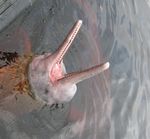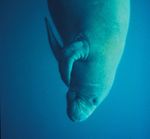LANDSCAPE LEVEL BIODIVERSITY BASELINE IN THE PERUVIAN AMAZON USING eDNA
←
→
Page content transcription
If your browser does not render page correctly, please read the page content below
NatureMetrics Case Study
LANDSCAPE LEVEL BIODIVERSITY BASELINE IN
THE PERUVIAN AMAZON USING eDNA
Summary
Company: WWF Peru WWF asked us if we could help them to survey Manatees and Pink
Type of sample: Aquatic eDNA River Dolphins in the Peruvian Amazon. With the same sample effort
Environment: Freshwater aquatic and cost as it would take to survey these two species, we worked
Group targeted: Vertebrates with local staff to deliver a comprehensive survey of the entire
vertebrate fauna of the rivers and surrounding forests – 675 species
in total. An amazing resource for understanding the conservation
priorities, risks and economic value of biodiversity in the area.
PIN
KR As part of their Healthy Rivers programme, WWF Peru were aiming to conduct a
I VE
RD baseline survey of pink river dolphins (Inia geoffrensis) and Amazon manatees
OL
PH
IN
(Trichechus inunguis) in the Northern Peruvian Amazon. They were also interested
in migratory catfish, which sustain many livelihoods in the area. The
NatureMetrics technology approach would provide vastly more data on
Amazonian biodiversity than traditional methods to survey these species.
Sampling
This was a vast, landscape-level survey, stretching from the Andean slopes in the
East to the Brazilian border in the West. The WWF Peru team conducted a single
boat trip along each of the rivers, covering the entire landscape in three separate
sampling trips. Using the NatureMetrics sampling kits, the team collected four
0.5 L eDNA samples at each of 40 points, giving a total of 160 samples.
AM
A ZO
NM
AN
ATE
EWWF CASE STUDY NatureMetrics | 2021
Iquitos
Yurimaguas
Key features of the landscape included:
è The Pongo de Manseriche, a deep, fast-flowing gorge where the Maranon River runs out of the Andes into
the lowland Amazon, representing a potential barrier to species and the upstream migration limits of
many fish species. Waterfalls run over the sides of the gorge from the forested hills above.
è The Pacaya Samiria National Park, one of the largest in Peru. The Maranon and Ucayali rivers run along
two sides of this triangular park, meeting at its apex to merge into the Amazon river. At this point it is
about 1km across.
è Black water and white-water habitats. White-water rivers are the colour or milky coffee and heavily laden
with sediments. Black-water rivers are clear and dark, rich in tannins and with a low pH. Black-water
tributaries often run into white-water rivers, giving distinctive mixing patterns where the black and white
waters meet. It is harder to filter large volumes of water in white-water rivers because the high sediment
load blocks the filter, which is why the team standardised water volume to 500 ml per sample.
è Heavily impacted landscapes. There is extensive oil and gas drilling in the region, and this is very much
in evidence, with some operations visible from the main river and many large petroleum boats traveling
up and down the river.
Analysis
Samples were analysed in our lab and by our data processing team using the vertebrate eDNA metabarcoding
assay, which uses a region of the 12S gene for species identification. These same samples could also be analysed
for even more biodiversity by targeting gene regions in bacteria, diatoms and invertebrates.
Page 2 of 5WWF CASE STUDY NatureMetrics | 2021
Results
Results revealed a staggering diversity of Amazonian vertebrate
Group Species
fauna, with 675 species including fish, mammals, birds, amphibians
and reptiles. Fish 375
Mammals 155
Both target mammal species – pink river dolphin and Amazon
manatee – were present in the dataset, and their distribution could Amphibians 74
be mapped across the study area. As well as presence at each site,
the replicate sampling design let us record the number of replicates Reptiles 6
(out of four) in which the species was detected at each location. Birds 65
Taken together with the number of sequence
reads for each detection, this occupancy or
frequency information helps us start to
understand how common each species is in the
landscape. It was no surprise to find the dolphins
detected almost universally in the lowland
samples, since they were very much in evidence
during sampling, often jumping around the boat
while samples were collected.
The Pongo de Manseriche marked the easternmost limit of the species distribution, suggesting that this acts as a
significant barrier to movement.
The manatees were mostly detected around the Pacaya Samiria national park, and at much lower frequency than
the dolphin – often showing up in just one of the four replicate samples at each site. No manatees were spotted
on the trip and they are notoriously difficult to survey since they spend most of their time submerged in murky
white-water rivers with only their nostrils poking out!
In addition to these species, we identified a huge variety of mammal species detected – including over 100 non-
aquatic species. These included:
è Small mammals (e.g. many species of rodents and opossums)
è Large ungulates such as tapirs, deer and peccaries
è Top predators including jaguar and ocelot
è Other terrestrial species such as giant anteaters and armadillos
è Arboreal species including almost all the monkey species known in the area
è 25 species of bat!
Each of these species could be mapped across the landscape in the same way as the dolphin and manatee.
Terrestrial mammals tend to be detected in only tiny traces of eDNA as they shed less of it into the water, so they
are mostly interpreted as incidental records. Behaviour plays a large part in detection of these species, particularly
in relation to their toilet habits - species that are very commonly detected (e.g. tapir) seem to be the ones that do
large poos in and around the river!
This wealth of information on so many species at this landscape scale would surely have taken many years and
millions of dollars to obtain using conventional survey methods – using eDNA it is all gathered for free as a by-
product of the dolphin and manatee survey!
Page 3 of 5WWF CASE STUDY NatureMetrics | 2021
Over half the species detected were fish –
which is what we would expect as fish shed
lots of DNA and the Amazon has the highest
diversity of freshwater fish in the world.
Only about 20% of the fish taxa could be
identified to species level because of
incomplete reference databases (i.e. the DNA
sequences obtained from our samples didn’t
match any of the sequences in the reference
library because many fish have not yet been
sequenced for the 12S gene). Where species
could not be named, they were named at higher
taxonomic levels (genus, family or order) and
names can be added later as reference libraries
are expanded.
Even in the absence of species names, we were able to use the species-level data to analyse diversity patterns in
the landscape, particularly how species composition changes across the landscape. We found that there was a
significant shift in the fish communities associated with the Pongo de Manseriche, which highlights the impact of
this natural landscape feature as a barrier to connectivity. We also found that there were very distinct communities
of fish in black-water rivers, indicating that some species are specialists of this acidic, tannin-rich habitat.
These patterns can be seen in the NMDS plot below. Each point is an eDNA sample. Points are coloured according
to the section of the landscape they come from and grouped together (by lines) with the other samples from the
same location (usually groups of 4). The closer together two points are, the more similar the species composition
of those two samples. The natural barrier is the Pongo de Manseriche, which separates the Upper Maranon from
the Mid Maranon. Note that one group of Mid Maranon samples (purple) is more similar to those from the Upper
Maranon (orange). These
samples were collected from
the point immediately below
the Pongo and probably
contains DNA washed down
from above it, leading upper
Maranon species to be
detected in these samples
even though they are
probably not present at the
sampling point. The
downstream transportation
of eDNA illustrated here is one
of the reasons that careful
planning of sampling design is
critical to ensure that key
questions can be addressed.
Our team of expert ecologists
are always happy to help with
this!
Page 4 of 5WWF CASE STUDY NatureMetrics | 2021
Summary
By using DNA-based methods, WWF Peru has met multiple goals by increasing their knowledge of the key species
in their study sites, supported by big data. They have set a strong biodiversity baseline to work from to enable the
measurement of biodiversity conservation outcomes in a robust and scalable way for the first time. Importantly,
WWF Peru has generated a more complete understanding of biodiversity in their Peruvian rivers, supported by
NatureMetrics to set a new standard for biomonitoring in conservation globally.
TESTIMONIAL
“With NatureMetrics’ innovative aquatic eDNA service, we at
WWF Peru were able to fully achieve our survey goal of
detecting the spatial distributions of six culturally and
commercially important aquatic species along the Marañon
river, and we exceeded our goal by also detecting hundreds
of additional vertebrate species, which we can now start to
take into account in designing a sensitive index of basin-
ecosystem health. Without eDNA and NatureMetrics, we
would have been relegated to visual surveys for just river - Brenda Toledo,
dolphins, itself requiring more field time than the eDNA Coordinator of
survey, and to opportunistic interviews for the other five Amazonian Healthy
target species, which are less reliable, auditable, and Waters Programme,
systematic. The hundreds of other species detections would WWF Peru
not have been possible at all.”
Page 5 of 5You can also read



























































